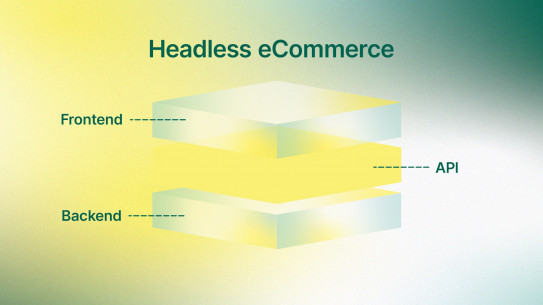Adopting a Headless Approach with Traditional B2B e-Commerce Systems
Considering a headless or composable approach but you're tied to a conventional B2B e-Commerce system? Fear not - transitioning to a headless system is less complex than you might believe. Read on to learn how your enterprise can leverage the advantages of a headless architecture while still utilizing your existing monolithic e-Commerce solution.
What is headless commerce?
Headless refers to an e-Commerce architectural method where the front-facing layer of a site or application is separated from the backend, or commerce functionality.

The headless approach promotes greater adaptability, scalability, and enables the tailoring of user experience across multiple devices, touchpoints, and channels.
Benefits of Headless Commerce for B2B Businesses
Here are the compelling reasons to consider adopting a headless approach:
Headless systems use APIs to seamlessly integrate various software tools, eliminating the constraints of a vendor-specified system. This enables a fluid interchange of data and broadens the scope of your data collection and usage, providing you the flexibility to customize your data infrastructure as per your needs.

Headless systems help deliver a cohesive experience at every interaction point by centralizing all customer data and providing a comprehensive API layer. In the B2B context, a company might need to interact with its clients via various online channels such as a web portal, a mobile app, a partner portal, email, social media, or even IoT devices.
By effectively utilizing a headless system, a business can offer consistent, personalized, and contextually relevant experiences to its clients across all these touchpoints, enhancing overall client satisfaction and loyalty.
Headless commerce offers opportunities to experiment with different user experiences and pricing structures. You can implement new features or products, test discounts or promotions, experiment with different page layouts and create fascinating customer experiences without having to worry about the backend.
Headless commerce solutions support emerging technologies, enabling marketing teams to quickly launch multiple sites and keep pace with evolving customer expectations. Headless platforms provide flexibility, enabling you to experiment and innovate without compromising backend operations.
Beneficial for your enterprise
Eventually, as you migrate all the necessary components to the headless solution, you can fully transition to a decoupled storefront. At this stage, the monolith no longer serves as the front-end interface, but rather as the central data platform, providing back-end functionality and serving data through APIs to the headless front end.
By following this gradual transition, you can unlock the benefits of a headless architecture while still leveraging your existing monolithic platform. The process allows you to combine the stability and functionality of the monolith with the flexibility, customization, scalability, and integration capabilities offered by a decoupled front end.
Transitioning to a headless system with a traditional e-Commerce platform, even when you have existing investments or long-term contracts, is not only simple but also highly beneficial for your enterprise. It enables you to stay agile, experiment with emerging technologies, and future-proof your business in the evolving e-Commerce landscape.
Transitioning to Headless in Three Simple Steps
The decision to retain or switch your e-Commerce platform depends on the level of customization and specific custom development you have implemented in the monolithic platform.
For small businesses with significant customization, introducing APIs and microservices can strategically enhance specific experiences within the existing platform. This approach allows you to keep up with emerging client expectations without undergoing a complete platform transition.
On the other hand, mid-market or enterprise companies may prefer transitioning to a more comprehensive and agile SaaS solution for increased scalability and flexibility in the long run. This move enables them to leverage a robust and flexible platform with built-in scalability, regular updates, and integrated features.
Ultimately, assessing the effectiveness of your current system and considering your future growth needs will help determine whether to retain or switch your e-Commerce platform.
When choosing a headless front end for your e-Commerce platform, consider frameworks like Vue Storefront, SAP Composable Storefront (Spartacus), and Next.js or Nuxt.js. These frameworks provide pre-built templates and customizable options, allowing you to expedite development while still tailoring the storefront to your branding and requirements.
A headless front end enables you to deliver diverse content across multiple channels and devices, with customized content logic for each channel and user experience. By utilizing APIs, the headless front end connects to your back end, ensuring the delivery of relevant content to the right touchpoints.
Implementing a Progressive Web App (PWA) as part of your headless front end brings added benefits. PWAs offer a fast, reliable, and engaging user experience, with features like offline accessibility and push notifications, enhancing user engagement and conversion rates.
By leveraging templated storefronts and frameworks like Vue Storefront, SAP Composable Storefront, Next.js, or Nuxt.js, you can accelerate development, benefit from responsive design and pre-built functionality, and customize the storefront to meet your specific needs.
In summary, choosing a headless front end with frameworks like Vue Storefront, SAP Composable Storefront, or Next.js/Nuxt.js, and incorporating PWAs, allows you to deliver personalized and engaging content, improve user engagement, and expedite development efforts.
In the B2B context, synchronizing your headless front end with APIs is crucial for seamlessly integrating the user experience and backend operations. Take a step-by-step approach when migrating from a conventional B2B platform. Start by synchronizing APIs for smaller sections like order management or inventory tracking. Gradually expand to other B2B functionalities, optimize, and scale up. This ensures a smooth integration, improving efficiency, flexibility, and customer satisfaction in your B2B e-Commerce solution.
Final Thoughts

Headless and composable are undoubtedly the future of e-Commerce, and there's no better time to get started. Transitioning to headless or composable doesn't have to be a drastic change; simply decoupling the front end is sufficient to enjoy the benefits.
Are you considering the transition to a headless architecture for your business? SQLI is here to provide guidance and support throughout the process.


